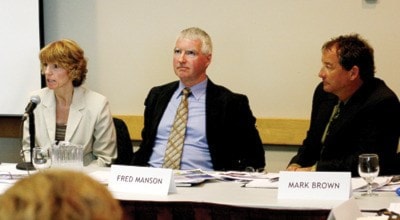With the tabling of a major report on the Arrowsmith Water Service (AWS) in April, at least one resident is raising concerns about the lack of big picture planning.
“The AWS has taken it upon themselves to do this work with no master plan for the region,” said Trevor Wicks, who said he has been involved in water issues in the region for 18 years.
He said there are currently 54 competing water-use plans and despite it being the centrepiece of the AWS, the Arrowsmith Dam only catches 1.5 per cent of the watershed.
He said that of the 50,000 people in Oceanside only 9,000 get any water from the Englishman River through the AWS, so people shouldn’t think that a water treatment plant will solve all the problems.
“Unless we look at the whole picture, we’re deceiving a large amount of people,” he said, adding there are serious issues developing from the lack of coordinated, long-term planning. He points to issues like the dropping level of an obsservation well in Parksville. The City of Parksville currently gets most of its water from deep wells. There are two test wells and the one in the Springwood well field has dropped 3.5 metres since 1988, according to manager of operations Mike Squire.
He explained there is no known bottom, no easy way to measure the total supply, which is partially replenished by groundwater.
He did say the dropping level at which water is found is one of several reasons the city needs to the new Englishman River intake and treatment facility.
Currently the city can only use river water from May to October when turbidity is lower, which isn’t a problem since it only needs the well water in the peak summer months.
But with increasing population, hotter dryer summers and the unknown future of the wells, they will need more water out of the river sooner than later.
Wicks was more alarmed about the drop in the city well, explaining that a well dropping year over year is proof it is being depleted faster than the groundwater can recharge it. That leads to problems with pulling in contaminated water and not flushing the system out properly.
He is generally concerned about the quality of water in the region, pointing out there are numerous areas of possible contamination including cemeteries, auto-wreckers, landfills, roads, railways, gravel pits and old failing septic systems.
He is skeptical of official water quality tests he said, he has seen tests over the years with some of the creeks emptying into the Englishman River containing bacteria levels close to that of raw sewage.
“This is Walkerton in slow motion, it’s downright scary,” he said of the lack of coordinated planning and proper oversight.
He believes the proposed $50 million water treatment facility is a good step, but a small piece in a large jigsaw puzzle and he’s not a fan of the ASR (aquifer storage and recovery) idea proposed in the recent AWS report.
He said the idea of spending money to pump water from the river, treat it, then pumped into the ground somewhere else for storage and then trying to pump the same water back out — to use to flush toilets and water lawns — is absurd.
The AWS board is just beginning to look into the possibility of that newer process, which is done in some parts of the world but is still uncommon in Canada.
Wicks said he will be talking to local municipalities and any relevant groups he can about some of his recommendations, including a real emphasis on reducing water use, mandating the storage and use of rainwater, using multi-sources, using sand filtration to pre-clean, developing mini water towers in each neighbourhood, developing grey water systems to use non-potable water for things like flushing toilets, and functional landscapes to retain and use less water.
Most political jurisdictions in the area have some water conservation programs in place, with the notable success of Parksville’s AquaStar program leading to a 23 per cent drop in residential use last year.
Wicks points out there isn’t a co-ordinated regional effort.
